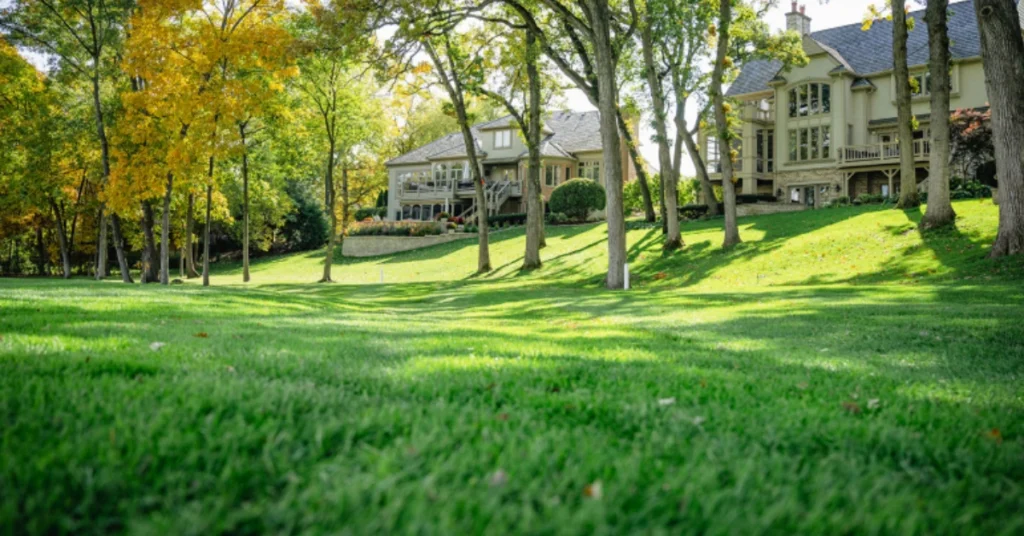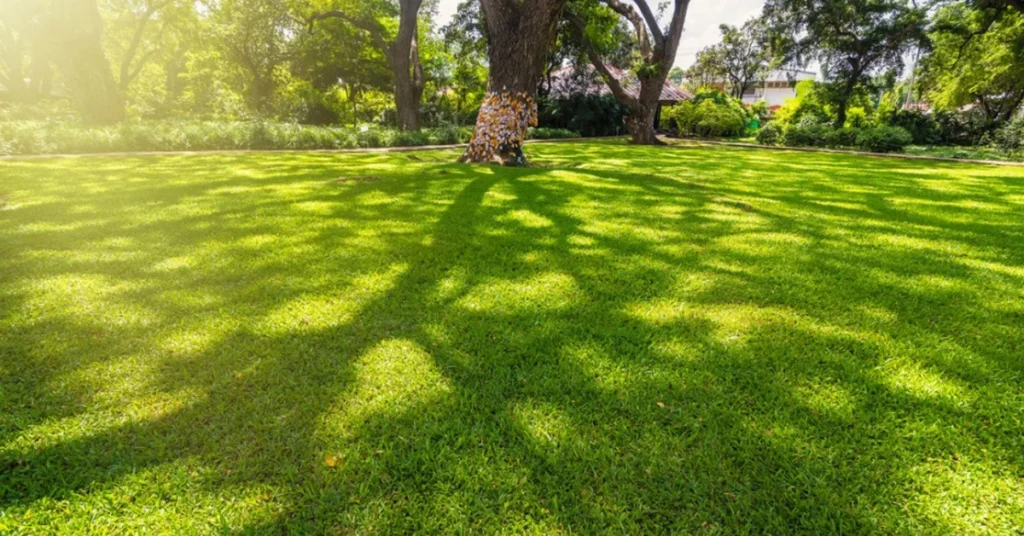It can be a bit of a challenge to create a lovely, green lawn in a limited sunlight area, but it can be easier than you may think. Whether you have large trees, high buildings, or some other shade-creating things in your yard, it is important to choose the right grass seed for shade. Many types of grass do not tolerate shade, so knowing which ones do well is important. Below, we’ll discuss the best grass seed for shade, how to choose the right one for your yard, and ways to plant and maintain a healthy shade-adapted lawn.
What Is the Best Grass Seed for Shade?
When it comes to establishing a lawn in the shade, not all grass seed types are created equal. The best grass seed for shaded areas is one that can overcome the fact that there will be little to no direct sunlight, and that will also minimize the problems that resist these types of areas: wet, moist soil, and slow evaporation rate. Grasses that are well adapted to shade will often have wider blades to catch light for photosynthesis and have slower growth rates to slower stress in low-light conditions. Fine fescues, tall fescues, and some Kentucky bluegrass cultivars are some of the best options for shady lawns that offer options in terms of degree tolerance, appearance, and maintenance requirements.
Understanding Shade-Tolerant Grass Types
Shade-friendly grasses, trees , and even some buildings can block the sun from reaching your lawn, which can be problematic for grass. They tend to have wider leaves for capturing more light and are better at photosynthesis in low light. Shade-tolerant grass types include fine fescue, tall fescue and some cultivars of Kentucky bluegrass or zoysia grass.
How Much Shade Is Too Much for Grass to Grow?
But even shade-tolerating grasses need a certain amount of sunlight to perform photosynthesis. Most shade-tolerant grasses require at least 3 to 4 hours of sun in direct sunlight or 4 to 6 hours of dappled sun each day. Darker corners may not get enough light to promote the growth of good, dense grass.
What Makes a Grass Seed Good for Shaded Areas?

The best grass seed for shade should have:
- Low Light Tolerant: Can grow with little sunlight.
- Resistant to disease: Shade can often mean damp, good for fungal diseases; resistant varieties do better there.
- Easy to Maintain: A slower growth habit means less mowing.
- Tolerance: Will grow in many types of soil and will tolerate wet or dry soil.
- Adaptability: Ability to thrive in various soil types and moisture levels.
Top Grass Seed Varieties for Shaded Lawns
Although not all species of grass are well-suited for shade, many turf grasses also tend to be more shade-tolerant. Let’s take an in-depth look at the top shade-tolerant grass seed available on the market, complete with its strengths, growth habits, and preferred conditions. Whether you have light, moderate, or heavy shade, there is a type of seed that complements your lawn’s needs. Choosing the best shade grass seed is the key factor to success. Here are a few high-performing varieties:
Fine Fescue – Best Choice for Shade
Fine fescues, including Creeping red, chewings, hard, and sheep fescues, have a reputation for shade tolerance. They are well-suited to low-light areas and are low-maintenance, which makes them perfect for shaded backyards. However, because of their fragile blades, they are not ideal for areas with high human traffic.
Perennial Ryegrass – Fast-Growing for Partial Shade
It germinates quickly and can occur in as little as 5 to 10 days. It performs well in partial shade, but prefers more sun than fine fescues. Its rapid growth makes it ideal for overseeding and fast lawn repairs.
Tall Fescue – Durable and Versatile for Low Light
It has great drought tolerance and moderate shade tolerance. It is very adaptable to different soil types and is more foot traffic tolerant than fine fescues. Tall fescue is useful for lawns with a combination of sun and shade.
Kentucky Bluegrass – Works in Filtered Shade
Kentucky bluegrass prefers full sun, but can tolerate light to moderate shade, especially with some of the newer cultivars developed to have better shade tolerance. It is a dense-growing species that regenerates well after damage and is often used in lawns, often under varying light conditions.
Zoysia Grass – Warm-Season Option for Light Shade
Zoysia grass is a warm-weather turf that can handle some light shade and is popular for its “carpet-like” growth. It is more drought-tolerant and the slower-growing variety rarely needs cutting. Zoysia is best suited in the South and other regions with relatively warm winters.
How to Choose the Best Grass Seed for Your Shaded Yard

Picking the right grass seed isn’t as easy as picking a product marketed as shade-tolerant. You will want to consider your local climate, the amount of shade, and what the lawn requires to make the best decision. However, there are key things to think of before making that purchase of the best grass seed to establish your unique shaded space.
Cool-Season vs. Warm-Season Grasses
- Cool-Season Grasses: These grow best in the cooler temperatures of the northern part of the country. Some examples are fine fescue, tall fescue, and Kentucky bluegrass.
- Warm-Season Grasses – They grow in the south where temperatures are warm. Zoysia – Zoysia grasses and St. Augustine grass are the most popular types of warm-season grasses.
Matching Grass Seed to Your Climate and Sun Exposure
Determine how much sunlight your lawn receives and purchase grass seed accordingly. Fine fescue is probably best for complete shade. However, for partially shaded lawn areas in heat-climate regions, zoysia grass may be a better choice.
Best Grass Seed Mixes for Shade in the U.S.
Some shady-seed mixes have been created:
- Super Shade Fine Fescue Blend: Ideal for medium to dense shade areas.
- Shade Savant Blend: A combination of perennial ryegrass and fine fescue for increased shade performance.
- Jonathan Green Black Beauty Dense Shade: A blend of tall fescue, perennial rye, Kentucky bluegrass, and fine fescue for dense shade.
Tips for Growing Grass in Shady Areas
The best grass seed fails to grow without the right care techniques made for shade conditions. From soil preparation to watering and mowing heights, this section provides you with practical advice that can improve your chances of cultivating a thriving lawn in low-light environments.
Preparing Soil for Shade Grass Seed
- Soil Testing: Balance the soil pH and nutrients to condition the soil.
- Breaker: Increases the soil’s structure and enhances root development.
- Organic Material: Add compost to help retain moisture and add nutrients.
Mowing, Watering, and Fertilizing for Shade Lawns
- Mowing: Keep grass 3-4 inches high to encourage maximum photosynthesis.
- Watering: Water deeply but infrequently to develop deep roots.
- Fertilizing: Use balanced fertilizer without over-fertilizing, which can promote disease in shaded areas.
When and How to Overseed in Shaded Spots
- Timing: Early fall is best for overseeding in cool-season regions; late spring if you live in a warm-season area.
- Preparation: Clear the area of any debris and lightly rake the soil to loosen.
- Seeding: Sprinkle seed evenly and lightly cover with topsoil or sand/mulch to about 2mm deep, maintaining the moisture.
How to Increase Sunlight and Airflow for Better Growth
- Pruning: Prune overhanging tree branches to let more light into the lawn.
- Thinning Shrubs: To open up dense shrubs and improve air circulation and light penetration.
- Strategic Planting: Position plants and structures to reduce shadows over lawns.
Common Mistakes to Avoid When Planting Grass in Shade
Planting grass in these low-light areas comes with a lot of challenges and common mistakes. But many homeowners unwittingly sabotage their efforts by choosing the wrong varieties of grass or the wrong maintenance practices for their region. In this post, we will review the most common mistakes and how to avoid them to have a beautiful lawn long term in shaded areas. By avoiding common pitfalls, your success with a shaded lawn will be much better.
Using the Wrong Grass Type
A poor or struggling lawn is usually due to using a variety of grasses unsuitable for the amount of shade the lawn receives. Always opt for a Low-light seed mix.
Overwatering or Underwatering Shaded Areas
Moisture stays in shaded areas for a longer time, leading to the likelihood of becoming an over-watering paradox and a fungal target zone. On the other hand, a dry period without watering can stress the lawn. Then, examine the soil to determine how often it should be watered.
Ignoring Tree Competition for Light and Nutrients
Trees compete with grass for sunlight, water, and nutrients. Keep trees pruned to improve light availability and consider additional fertilization to boost grass vigor.
Conclusion
You can establish a healthy lawn in shaded areas! With the right shade-resistant types of grass and the right soil prep, you can get a nice patch of green, even if it’s mighty shady! Be sure to evaluate your circumstances and select grass seeds that match your area’s climate and sunlight exposure.
FAQs
Fine fescues, including creeping red, chewings, and hard fescue, are some of the most shade-tolerant grasses, and you could use these in very shady places.
Yes, it helps, adding that even if you use something else in the spring sun, you probably have a good reason to rely on fine fescue and other shade-tolerant varieties to provide a boost in the spring sun.



